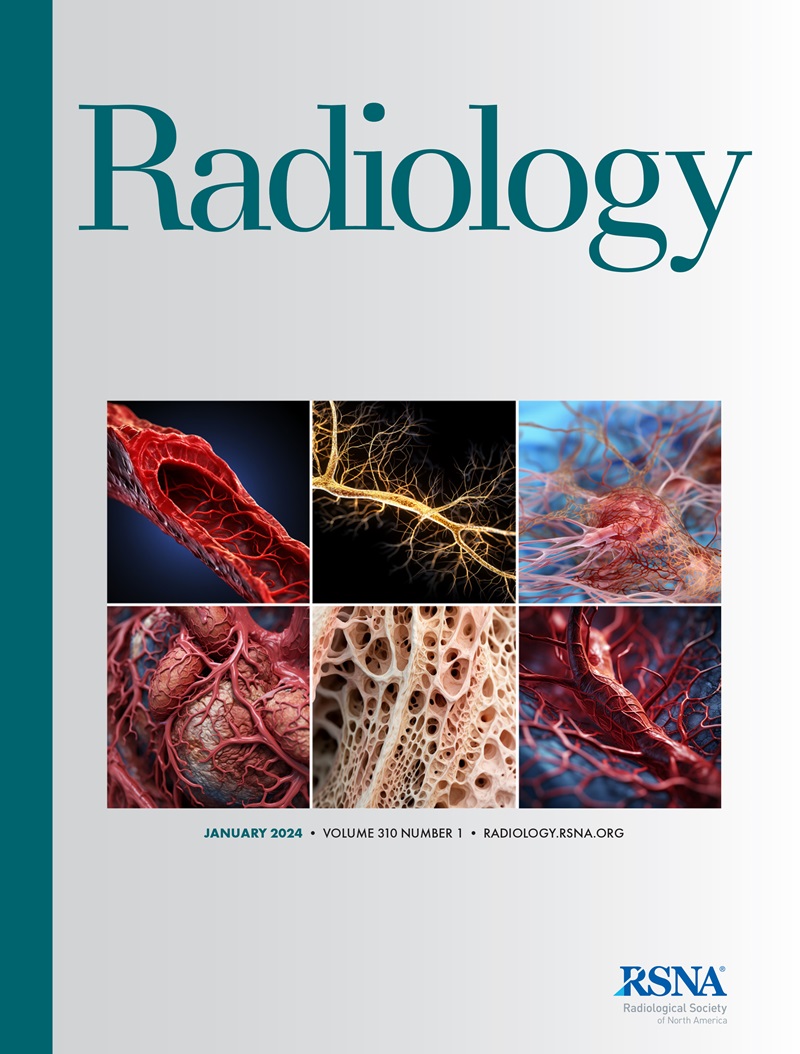Hongyan Huang, Junyang Mo, Zhiguang Ding, Xuehua Peng, Ruihao Liu, Danping Zhuang, Yuzhong Zhang, Genwen Hu, Bingsheng Huang, Yingwei Qiu
求助PDF
{"title":"深度学习模拟对比增强MRI评估疑似前列腺癌。","authors":"Hongyan Huang, Junyang Mo, Zhiguang Ding, Xuehua Peng, Ruihao Liu, Danping Zhuang, Yuzhong Zhang, Genwen Hu, Bingsheng Huang, Yingwei Qiu","doi":"10.1148/radiol.240238","DOIUrl":null,"url":null,"abstract":"<p><p>Background Multiparametric MRI, including contrast-enhanced sequences, is recommended for evaluating suspected prostate cancer, but concerns have been raised regarding potential contrast agent accumulation and toxicity. Purpose To evaluate the feasibility of generating simulated contrast-enhanced MRI from noncontrast MRI sequences using deep learning and to explore their potential value for assessing clinically significant prostate cancer using Prostate Imaging Reporting and Data System (PI-RADS) version 2.1. Materials and Methods Male patients with suspected prostate cancer who underwent multiparametric MRI were retrospectively included from three centers from April 2020 to April 2023. A deep learning model (pix2pix algorithm) was trained to synthesize contrast-enhanced MRI scans from four noncontrast MRI sequences (T1-weighted imaging, T2-weighted imaging, diffusion-weighted imaging, and apparent diffusion coefficient maps) and then tested on an internal and two external datasets. The reference standard for model training was the second postcontrast phase of the dynamic contrast-enhanced sequence. Similarity between simulated and acquired contrast-enhanced images was evaluated using the multiscale structural similarity index. Three radiologists independently scored T2-weighted and diffusion-weighted MRI with either simulated or acquired contrast-enhanced images using PI-RADS, version 2.1; agreement was assessed with Cohen κ. Results A total of 567 male patients (mean age, 66 years ± 11 [SD]) were divided into a training test set (<i>n</i> = 244), internal test set (<i>n</i> = 104), external test set 1 (<i>n</i> = 143), and external test set 2 (<i>n</i> = 76). Simulated and acquired contrast-enhanced images demonstrated high similarity (multiscale structural similarity index: 0.82, 0.71, and 0.69 for internal test set, external test set 1, and external test set 2, respectively) with excellent reader agreement of PI-RADS scores (Cohen κ, 0.96; 95% CI: 0.94, 0.98). When simulated contrast-enhanced imaging was added to biparametric MRI, 34 of 323 (10.5%) patients were upgraded to PI-RADS 4 from PI-RADS 3. Conclusion It was feasible to generate simulated contrast-enhanced prostate MRI using deep learning. The simulated and acquired contrast-enhanced MRI scans exhibited high similarity and demonstrated excellent agreement in assessing clinically significant prostate cancer based on PI-RADS, version 2.1. © RSNA, 2025 <i>Supplemental material is available for this article.</i> See also the editorial by Neji and Goh in this issue.</p>","PeriodicalId":20896,"journal":{"name":"Radiology","volume":"314 1","pages":"e240238"},"PeriodicalIF":12.1000,"publicationDate":"2025-01-01","publicationTypes":"Journal Article","fieldsOfStudy":null,"isOpenAccess":false,"openAccessPdf":"","citationCount":"0","resultStr":"{\"title\":\"Deep Learning to Simulate Contrast-Enhanced MRI for Evaluating Suspected Prostate Cancer.\",\"authors\":\"Hongyan Huang, Junyang Mo, Zhiguang Ding, Xuehua Peng, Ruihao Liu, Danping Zhuang, Yuzhong Zhang, Genwen Hu, Bingsheng Huang, Yingwei Qiu\",\"doi\":\"10.1148/radiol.240238\",\"DOIUrl\":null,\"url\":null,\"abstract\":\"<p><p>Background Multiparametric MRI, including contrast-enhanced sequences, is recommended for evaluating suspected prostate cancer, but concerns have been raised regarding potential contrast agent accumulation and toxicity. Purpose To evaluate the feasibility of generating simulated contrast-enhanced MRI from noncontrast MRI sequences using deep learning and to explore their potential value for assessing clinically significant prostate cancer using Prostate Imaging Reporting and Data System (PI-RADS) version 2.1. Materials and Methods Male patients with suspected prostate cancer who underwent multiparametric MRI were retrospectively included from three centers from April 2020 to April 2023. A deep learning model (pix2pix algorithm) was trained to synthesize contrast-enhanced MRI scans from four noncontrast MRI sequences (T1-weighted imaging, T2-weighted imaging, diffusion-weighted imaging, and apparent diffusion coefficient maps) and then tested on an internal and two external datasets. The reference standard for model training was the second postcontrast phase of the dynamic contrast-enhanced sequence. Similarity between simulated and acquired contrast-enhanced images was evaluated using the multiscale structural similarity index. Three radiologists independently scored T2-weighted and diffusion-weighted MRI with either simulated or acquired contrast-enhanced images using PI-RADS, version 2.1; agreement was assessed with Cohen κ. Results A total of 567 male patients (mean age, 66 years ± 11 [SD]) were divided into a training test set (<i>n</i> = 244), internal test set (<i>n</i> = 104), external test set 1 (<i>n</i> = 143), and external test set 2 (<i>n</i> = 76). Simulated and acquired contrast-enhanced images demonstrated high similarity (multiscale structural similarity index: 0.82, 0.71, and 0.69 for internal test set, external test set 1, and external test set 2, respectively) with excellent reader agreement of PI-RADS scores (Cohen κ, 0.96; 95% CI: 0.94, 0.98). When simulated contrast-enhanced imaging was added to biparametric MRI, 34 of 323 (10.5%) patients were upgraded to PI-RADS 4 from PI-RADS 3. Conclusion It was feasible to generate simulated contrast-enhanced prostate MRI using deep learning. The simulated and acquired contrast-enhanced MRI scans exhibited high similarity and demonstrated excellent agreement in assessing clinically significant prostate cancer based on PI-RADS, version 2.1. © RSNA, 2025 <i>Supplemental material is available for this article.</i> See also the editorial by Neji and Goh in this issue.</p>\",\"PeriodicalId\":20896,\"journal\":{\"name\":\"Radiology\",\"volume\":\"314 1\",\"pages\":\"e240238\"},\"PeriodicalIF\":12.1000,\"publicationDate\":\"2025-01-01\",\"publicationTypes\":\"Journal Article\",\"fieldsOfStudy\":null,\"isOpenAccess\":false,\"openAccessPdf\":\"\",\"citationCount\":\"0\",\"resultStr\":null,\"platform\":\"Semanticscholar\",\"paperid\":null,\"PeriodicalName\":\"Radiology\",\"FirstCategoryId\":\"3\",\"ListUrlMain\":\"https://doi.org/10.1148/radiol.240238\",\"RegionNum\":1,\"RegionCategory\":\"医学\",\"ArticlePicture\":[],\"TitleCN\":null,\"AbstractTextCN\":null,\"PMCID\":null,\"EPubDate\":\"\",\"PubModel\":\"\",\"JCR\":\"Q1\",\"JCRName\":\"RADIOLOGY, NUCLEAR MEDICINE & MEDICAL IMAGING\",\"Score\":null,\"Total\":0}","platform":"Semanticscholar","paperid":null,"PeriodicalName":"Radiology","FirstCategoryId":"3","ListUrlMain":"https://doi.org/10.1148/radiol.240238","RegionNum":1,"RegionCategory":"医学","ArticlePicture":[],"TitleCN":null,"AbstractTextCN":null,"PMCID":null,"EPubDate":"","PubModel":"","JCR":"Q1","JCRName":"RADIOLOGY, NUCLEAR MEDICINE & MEDICAL IMAGING","Score":null,"Total":0}
引用次数: 0
引用
批量引用

 求助内容:
求助内容: 应助结果提醒方式:
应助结果提醒方式:


